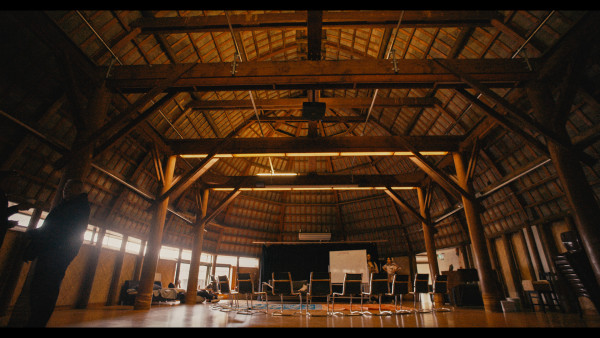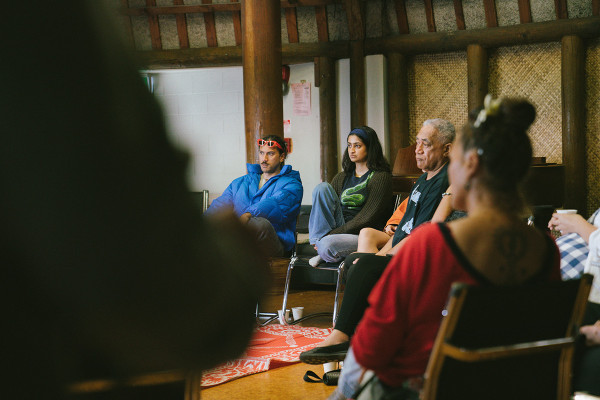A monument of national historical significance is at risk of falling into disrepair. It’s located on one of the country’s busiest streets - but you’ve likely never seen it.
Tucked behind a nondescript shop on Karangahape Road lies Maota Samoa or Samoa House - a tall, wooden traditional Samoan fale (house) with an oval-shaped thatched roof.
Built in 1979, it was the first fale constructed outside of Samoa. Its opening was met with huge fanfare and represented the arrival of the Pacific diaspora in Aotearoa.
It became the beating heart of the Pasifika community here - a tangible measina (treasure) early migrants hoped to leave behind for future generations.
It’s a legacy advocates now fear could be lost - not only is the structure itself said to be in a state of neglect but advocates say the Pasifika community is being restricted from accessing it.
Friends of Maota Samoa is a grassroots committee dedicated to bringing life back into the Maota through its repair and protection.
The group says restoring the fale to its former glory is particularly important as there’s very little recognition of the central city’s Pasifika history. The significance of Samoa House and the fight for its future feature in season two of the STILL HERE docu-series.
“We are ghosts on streets we helped develop, with buildings left to rot where our Pacific heart beated for so long,” committee member Olivia Tauoma says.
Pacific people’s history and place in Aotearoa extends beyond the fale’s walls and across Central Auckland. From the 1950s to the 1980s Karangahape Road and its surrounding areas - Newton, Ponsonby and Grey Lynn - were home to many of the first generation of Pasifika migrants. Streets that are now largely dominated by middle-class Pākehā, were lined with Polynesian businesses catering to the inner-city’s largest population.
Many from the Pacific Islands were enticed to come to “the land of milk and honey” to work in factories with the idea that they could provide a better future for their aiga (family) in a country seen to have better education and resources. The factories were located in Central Auckland so most families found homes close by.
The creation of Maota Samoa was a huge feat for Pacific communities at the time as that first generation of Island-born New Zealanders had their dreams and aspirations etched into the building’s very fibre.
It symbolised the struggle the earliest migrants went through trying to find their own identity in the urban new world that was so different to the island paradise they left in pursuit of better economic opportunities.
“The Maota is a story of struggle and overcoming… the people behind it were humble working class parents,” says Reverend Mua Strickson-Pua, whose father was one of the key people who helped turn Maota Samoa from a vision into reality.
“It was an outstanding, cohesive coming together of inner-city Pacific Islanders.”

Caption: The Maota Samoa fale. (Source: Geoffery Matautia)
The initial seed money for the building was fundraised out of the Pacific communities’ own pockets. Pasifika migrants from all over the moana - Samoans, Tokelauans, Niueans, Tuvaluans, Tongans, Kūki' Āirani - and also tangata whenua, fought hard to bring the vision to life.
Both the Samoan and New Zealand governments later got involved in its construction. The building became a reflection of the relationship between the two countries and it was decided it would house the Consulate-General of Samoa.
Urbanisation and gentrification in Central Auckland in the 1970s and 1980s saw factories moved out of the city area. Many Pasifika families were then forced to move to South and West Auckland.
“Gentrification was introduced because the Palagis (Europeans) during the fuel crisis became aware that they were stuck in the suburbs and they needed to be closer to their offices in Queen Street,” Reverend Strickson-Pua says.
As the city expanded, many Pasifika families' homes opposite Maota Samoa were destroyed for the expansion of the Southern Motorway.
“All down near the gully were all working class people living in houses,” Pua says. “The motorway came in and that took all our people out. (There used to be) a Pasifika population all underneath the bridge here in Karangahape Road.”
Advocates are worried that the history of these communities was removed at the same time.
Bonni Luafutu-Tamati is a committee member and the operations manager at Samoa House Library, a community space in the building created in response to the University of Auckland closing down their specialist libraries.
She is committed to preserving the importance of Samoa House to Central Auckland and the story of the communities who see the region as so important to their identity.
“The interesting thing about Maota Samoa is that there is no information about it at all. Archives have not been a priority to our Pacific Island communities. We have a form of knowledge holding however, and it is in our people,” Luafutu-Tamati says.
The Samoan Consulate moved south with the people and was shifted to Māngere in 2016, but Maota Samoa remains.
But without its people, the building became quiet and began to decline. Few businesses inhabit its walls now and many from the Samoan community say it is difficult for them to access the building, which they say goes against its intended purpose.
The Samoan Government still owns the building, which Friends of Maota Samoa say is a lifeline, but it has no active involvement in day-to-day operations - an overseas agency does this on the government’s behalf.
Friends of Maota Samoa says the community has to pay a significant amount to use the fale and Pasifika are not prioritised when it comes to leasing out the building’s business spaces.
The advocacy groups say this has left those with familial ties to the Maota unhappy as they want to use the building the way their elders intended.
“We don't have a relationship with the Samoan government … we would like them to be more present here, to see what they have as a taonga because no one knows what’s going on, what's needed, how people want to be involved in this building - there's many people who want to utilise it,” Bonni Luafutu-Tamati says.

“The heart and soul of it feels a little bit dented but the life that it's missing at the moment, it can get back simply by having people fill it.” (Source: Geoffery Matautia)
Samoan High Commissioner, Afamasaga Faamatalaupu Toleafoa, served at Samoa House as Consul-General in the late 1970s. He says he recognises the historical and cultural significance of the building to the community.
He says he needs to liaise with the consulate in Auckland to find out what’s happening to the future of Samoa House.
“I understood there was an arrangement with a property management company so I really need to find out but if it's true that the fale especially is in a state of disrepair, then certainly I think we need to look at that very seriously and do something about it,” the High Commissioner told Re: News.
Friends of Maota Samoa say the building could be used for education projects, activities, an archive for Pacific art and historical artefacts and a place where young Samoans can learn about their cultural identity.
“It’s happened once before in this building,” Bonni says. “The example is here, that you can make stuff happen. The generation that wanted this for us they did that, so we can’t waste that”.
Mario Gaoa, part of renowned comedy troupe Naked Samoans and co-writer of Bro’Town, used to run around the Maota as a child. He says the building could be used as a creative hub where Pasifika can use the commercial spaces inside.
“The heart and soul of it feels a little bit dented but the life that it's missing at the moment, it can get back simply by having people fill it,” Mario says.
Maota Samoa is a building ingrained in alofa (love), filled with an interconnectedness of stories that expand across generations. There’s much hope that it will continue to do so for future generations to come.
Made with the support of NZ On Air.
Watch the full season two of STILL HERE now.
More stories:
A love letter to the Pacific heart of Central Auckland
Director Litia and producers Torisse and Ursula reflect on the journey of making STILL HERE S2.
Grey Lynn’s last kava club | STILL HERE S2 | Episode 4
“The strength of the Tongan culture is in the kava.”
Why working hard doesn’t always make you rich
“I will be a Māori Millionaire.”